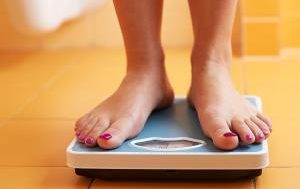The ‘Quarantine 15’: Weight gain (and loss) and the effects of stay-at-home
As summer approached, University of Missouri sophomore Nancy Metz found herself squeezing into her shorts and tank tops. In March, Metz moved to the Lake of the Ozarks with her grandmother after the university switched to online classes due to the coronavirus pandemic. Since then, Metz has gained 20 pounds.
“Over the past couple of months, I haven’t tried hard to lose my weight,” Metz said. “I’ll … make healthy meals, and I’ll keep it up for about four to five days. But then I crawl into bed later that night, Netflix on and a stash of cookies in my hand with a cold glass of milk on my nightstand.”
Although Metz isn’t a junk food junkie, her weakness is sweets, which she has noticed herself eating when she is anxious, stressed or depressed.
“For some reason, my brain tells me, ‘Just go eat something, you’ll feel better,’” Metz said. “At that moment, I feel better, but afterward, I feel worse because I just stuffed all this food in my mouth that isn’t going to benefit me. But what else am I going to do?”
Metz is not alone in her indulgences, according to Denise Wilfley, a professor of psychological and brain sciences at Washington University who studies the causes, prevention and treatment of eating disorders and obesity. Wilfley said that there has been a multifaceted shift in the eating habits of Americans during the pandemic.
“Millions of Americans being furloughed or otherwise losing their jobs and financial stability has increased financial stress and subsequently led to a lack of access to food,” Wilfley said.
In some cases, that’s led to stockpiling of groceries, which can increase the likelihood of problematic eating habits, she says. Another root cause may be the disruption in routines.
With the shift from office meetings to Zoom video conferences, and group pastimes on hold, the pandemic has caused an upheaval in the daily routines for a majority of Americans.
For college students like Metz, the transition to life in quarantine meant going from complete independence to not being able to choose what she eats for dinner.
“I tried to work out but this pandemic set me in a depression, and I had no energy to do anything. I was no longer social, no longer had a daily routine, no longer changed my environment. It was the same thing. Every. Single. Day.”
The closure of nonessential businesses and stay-at-home orders forced most Americans to wait out the storm at home. Some may have capitalized on the newfound free time by overcoming sedentary snacking and channeling their inner fitness fanatic. But for others, it just provided an opportunity for unbridled grazing.
Another contributing factor may be a marked decline in mental health.
“Research suggests that there is a connection between mental health and poor nutritional habits,” Wilfley said. “Given that early research has shown that there has been a significant increase in anxiety and depression during COVID-19, it stands to reason that the pandemic may be causing an increase in poor eating habits.”
Some people cope with mental health struggles by eating unhealthy foods that may temporarily provide a sense of relief or comfort.
Creating community
In some instances, social distancing restrictions have sparked creativity among St. Louisans, creating opportunities to get back to a healthy lifestyle — mentally and physically.
Nutritionist and personal trainer Julie Evans-Vitale, said exercise has been her escape during the pandemic. She posted a socially distant workout on Nextdoor to form the fitness-oriented group she misses from her gym, which closed temporarily as part of the quarantine.
Within a day of posting, Evans-Vitale received 20 responses from individuals willing to spend $10 for a curated workout and social interaction.
“I received a reply from a woman who’s 71, and I have some younger people,” Evans-Vitale said. “I didn’t want to limit (the workout) to only in-shape people. I just wanted to make it a way for people to move.”
Karen Handelman, of St. Louis, and her daughter Abby Hirshman were among the program’s first participants.
“We’ve been working out a lot as a family, but all of our organized workouts have been canceled, so we were looking for something different,” Handelman said. “I think working out with people, COVID or no COVID, is much more motivating.”
Organizing home workouts also can reset a tense family dynamic, especially when some family members are accustomed to leading an active lifestyle.
“It’s given us a way not to kill each other,” said Hirshman, a soccer and tennis player at Carleton College in Minnesota.
Evans-Vitale is no longer hosting socially distant workouts due to gyms reopening, but online alternatives still can be found for those not ready to step foot in a gym.
Experts offered several suggestions on how to get back on track to a healthier lifestyle:
Set realistic expectations: The pressure to fill extra time with productivity is overwhelming, but Wilfley said that we shouldn’t have the same expectations of life that we had three months ago. “I encourage everyone not to be too hard on themselves; everyone is bound to slip a little under stress,” she said. “If you find yourself starting to engage in unhealthy eating behaviors during this time, recognize that this is not uncommon, many others are going through the same thing. But strive to make small positive changes where you can.”
Prioritize your mental health: Those experiencing a decline in their mental health can utilize at-home resources available online, on sites such as nami.org. Staying in touch with a support system through video calls and seeking out positive experiences can help people maintain mental health.
Revamp your routine: Rather than scheduling your routine around work, practices and excursions, set specific mealtimes and wake-up times to create a structure that’s conducive to healthy eating habits.
Food fixes: Meal planning and reducing the amount of unhealthy snacks in the house is another step toward healthy habits. Evans-Vitale, a certified functional nutritionist, instructs clients to avoid sugar, inflammatory fats — canola oils, seed oils and hydrogenated oils — and alcohol. At the grocery store, she recommends buying leafy greens, microgreens, walnuts, bee pollen and algae foods, which can also be found online. She also recommends frozen vegetables when fresh items aren’t accessible.
Sticking with new habits
Dr. Megan Renner, a primary care physician in St. Charles, has not seen significant weight gain among her patients. In fact, she has noted the opposite.
“The pandemic has encouraged many individuals in our communities to begin home exercise programs while under stay-at-home orders,” Renner said. “As a result, I’m seeing significant progress being made toward weight-loss goals.”
Neman: Weight! Weight! Don’t tell me
At a recent Zoom meeting, food writer Daniel Neman asked what he thought was an innocent question.
Melanee May, of Bellefontaine Neighbors, has struggled with her weight her entire life, losing 75 pounds in recent years and later regaining 59. But during this pandemic, May has remained motivated. She wants to set a positive example for her children by using this time as an opportunity.
“Everything that I put into my mouth, I control,” May said, which can be empowering when events are out of your control.
Metz is also refocusing her mindset. She will be a horse wrangler this summer, adding a level of activity into her days.
“It’s up to me to make the decision to treat my body right, and that’s exactly what I plan on doing, during this COVID-19 crisis and after,” Metz said.



